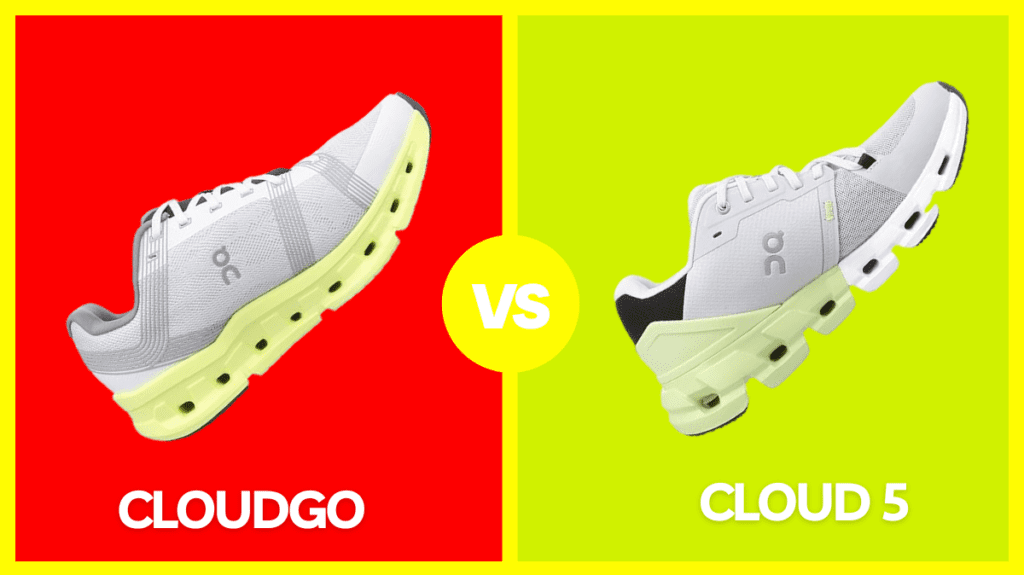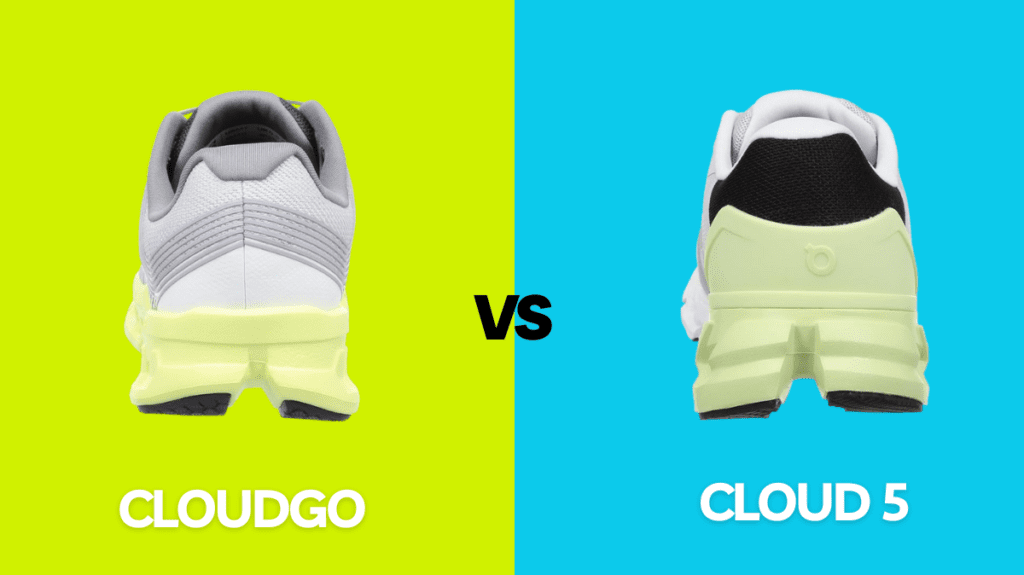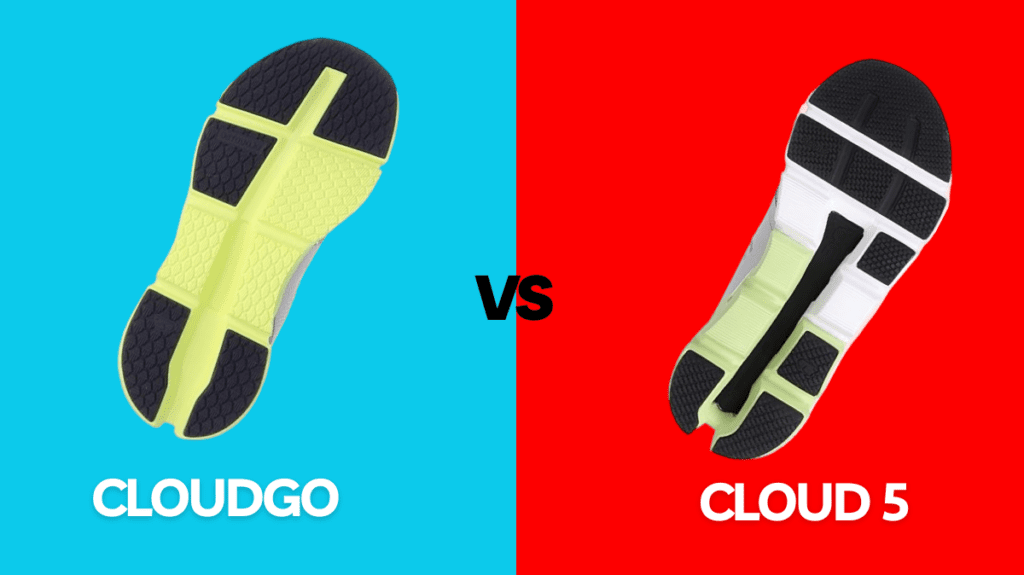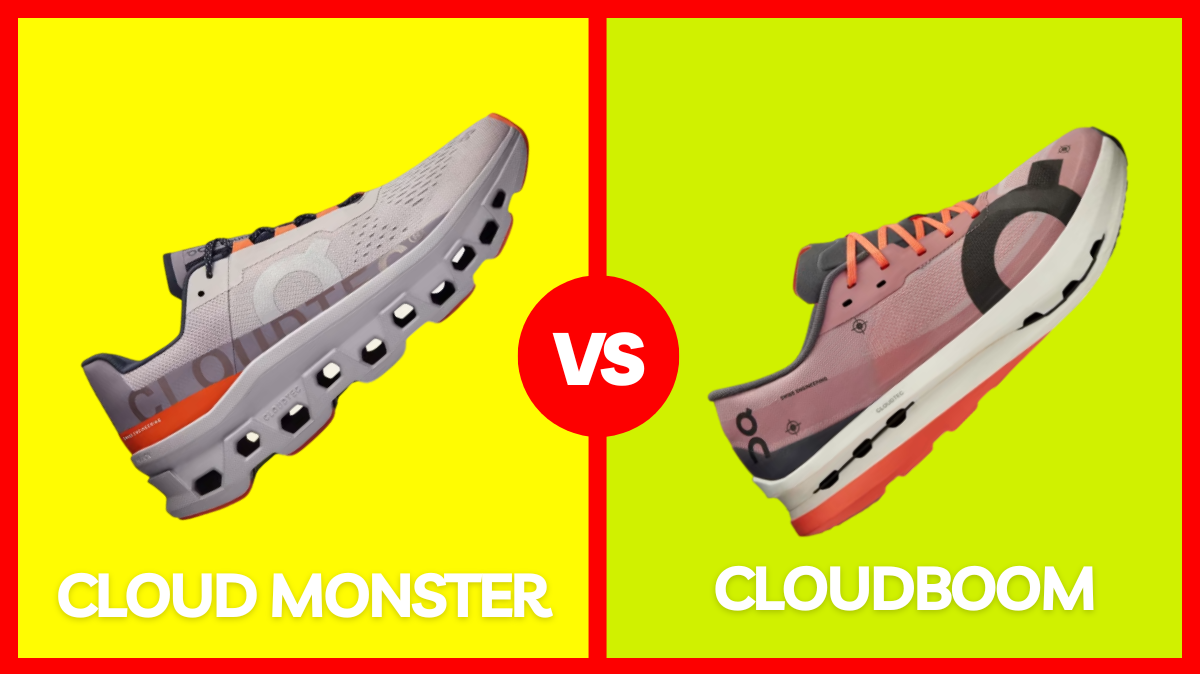Are you an avid runner looking to upgrade your running shoes? If so, you may be considering the Cloudgo or Cloud 5 shoes from On Running.
Both shoes are designed for optimal performance and comfort, but they have some key differences.
We’ll explore those differences in detail to help you decide which shoe is the better choice for your needs.

Contents
Cloudgo vs Cloud 5 Shoes
The main difference between Cloudgo and Cloud 5 shoes lies in their intended use. Cloudgo is designed for everyday wear and casual running, offering comfort for daily activities.
In contrast, Cloud 5 is geared towards more serious runners, providing enhanced performance features and cushioning for longer distances and intense training sessions.
Now, let’s create a detailed comparison table for Cloudgo vs Cloud 5 Shoes:
| Feature | Cloudgo | Cloud 5 |
| Brand | On Running | On Running |
| Purpose | Everyday running | All-round running |
| Weight | Approx. 230g (M), 190g (W) | Approx. 240g (M), 195g (W) |
| Cushioning | Helion™ superfoam | Helion™ superfoam |
| Upper | Engineered mesh | Engineered mesh with antimicrobial treatment |
| Outsole | CloudTec® in rubber | CloudTec® in rubber |
| Heel-to-toe drop | 8mm | 8mm |
| Price range | $129-$139 | $139-$149 |
| Stability | Moderate | Moderate to high |
| Durability | Good | Excellent |
| Flexibility | High | Moderate |
| Breathability | Very good | Excellent |
| Color options | Limited | Wide range |
| Best for | Daily runs, casual wear | Versatile running, all distances |
| Special features | Easier entry, more casual look | Reflective details, star-lacing system |
Summary: Both Cloudgo and Cloud 5 are quality running shoes from On Running, but they cater to slightly different needs. Cloudgo is lighter, more flexible, and designed for everyday runs and casual wear, with a more approachable price point.
Cloud 5, while slightly heavier, offers better durability, stability, and breathability, making it more suitable for versatile running across various distances. Cloud 5 also provides more color options and special features like reflective details, but at a slightly higher price. Your choice between the two would depend on your specific running needs and preferences.
Also Read: On Cloud vs Allbirds
Which Shoes Perfect for Any Activity
For Running
Cloudgo
Better for running, especially for daily training. It features enhanced cushioning and a more structured design.
- Has a CloudTec cushioning with larger cloud elements for better impact protection
- Includes a Speedboard for improved energy return
- Designed with a wider base for more stability during runs
Cloud 5
Suitable for short runs and speed work.
- Lighter weight (about 8.8 oz for men’s, 7.1 oz for women’s)
- More flexible, allowing for natural foot movement
- Less cushioning, which some runners prefer for faster-paced runs
For Walking
Cloud 5
Generally better for walking.
- Versatile design works well for casual walks and everyday wear
- Lightweight construction (about 20% lighter than Cloudgo) reduces fatigue
- Slip-on design makes them convenient for quick trips
Cloudgo
Also good for walking, but might feel slightly overbuilt for this purpose.
- Extra cushioning can be comfortable for longer walks
- More structured design provides better support for extended periods
For Standing All Day
Cloudgo
Better option for standing all day.
- Enhanced cushioning helps reduce fatigue during long periods of standing
- More structured design offers better support for extended wear
- Wider base provides improved stability
Cloud 5
Can work for standing, but not ideal for extended periods.
- Lighter weight might be preferable for some users
- Less cushioning may not provide enough support for all-day comfort

Durability
One of the most important factors to consider when purchasing running shoes is durability. After all, you want your shoes to withstand the wear and tear of frequent running sessions.
The Cloudgo and Cloud 5 shoes are both built to last. They feature durable outsoles made from high-quality rubber compounds, ensuring excellent traction and resistance to abrasion. However, the Cloudgo has a slight edge in durability due to its reinforced mesh upper, which is more resistant to rips and tears than the Cloud 5’s engineered mesh upper.
Breathing Ability
Breathability is another crucial factor, especially for runners who tend to overheat during their workouts. Proper ventilation can help keep your feet cool and dry, preventing blisters and other discomforts.
Both the Cloudgo and Cloud 5 shoes feature breathable mesh uppers, allowing air to circulate freely around your feet. However, the Cloudgo has larger ventilation holes in the forefoot area, providing slightly better breathability than the Cloud 5.
Cushioning
Cushioning is essential for absorbing the impact of each footstrike, reducing the stress on your joints and muscles. The level of cushioning you need depends on your running style, weight, and personal preferences.
The Cloudgo and Cloud 5 shoes both feature On Running’s signature CloudTec® cushioning system, which consists of individual cloud elements that compress and bounce back with each step. However, the Cloud 5 has a slightly thicker midsole, providing a softer and more cushioned ride compared to the Cloudgo.
Shoe Fit
A proper fit is crucial for comfort and performance. Running shoes that are too loose or too tight can lead to blisters, chafing, and other issues.
Both the Cloudgo and Cloud 5 shoes are available in a wide range of sizes, catering to different foot shapes and widths. However, the Cloudgo has a slightly roomier toe box, which may be more comfortable for runners with wider feet or those who prefer a more relaxed fit.
Also Read: Cloud Monster vs On Cloudboom Echo 3
Stability
Stability is an important consideration, especially for runners who overpronate (roll their feet inward) or supinate (roll their feet outward) during their stride.
The Cloudgo and Cloud 5 shoes both feature stability features, such as reinforced heel counters and medial posts, to help keep your feet aligned and reduce the risk of injury. However, the Cloud 5 has a slightly more pronounced medial post, making it a better choice for runners who require extra stability and motion control.
Stability Features
| Feature | Cloudgo | Cloud 5 |
| Heel Counter | Reinforced | Reinforced |
| Medial Post | Moderate | Pronounced |
Comfort
Comfort is a top priority for most runners, as discomfort can lead to blisters, chafing, and other issues that can derail your training routine.
Both the Cloudgo and Cloud 5 shoes are designed with comfort in mind. They feature plush tongue and collar padding, as well as moisture-wicking linings that help keep your feet dry and comfortable.

Quality
Quality is another important factor to consider when investing in a new pair of running shoes. High-quality shoes not only perform better but also tend to last longer, providing better value for your money.
Both the Cloudgo and Cloud 5 shoes are made from high-quality materials and are meticulously constructed to ensure durability and performance. However, the Cloud 5 has a slightly more premium feel, with a sleeker design and higher-end materials.
Style
While performance should be the top priority when choosing running shoes, style is also a consideration for many runners who want to look good while they work out.
The Cloudgo and Cloud 5 shoes both feature sleek and modern designs, but the Cloud 5 has a more streamlined and minimalistic look that some runners may find more appealing.
Also Read: Cloudmonster vs Hoka
Size
Finding the right size is crucial for a comfortable and secure fit, which can help prevent blisters, chafing, and other issues.
Both the Cloudgo and Cloud 5 shoes are available in a wide range of sizes, from men’s 7 to 14 and women’s 5 to 11. However, it’s important to note that sizing can vary between brands and models, so it’s always best to try on shoes before making a purchase.
Size Range
| Size | Cloudgo | Cloud 5 |
| Men’s | 7-14 | 7-14 |
| Women’s | 5-11 | 5-11 |
Material
The materials used in a running shoe can significantly impact its performance, durability, and comfort.
The Cloudgo and Cloud 5 shoes both feature high-quality materials, including breathable mesh uppers, durable rubber outsoles, and responsive CloudTec® midsoles. However, the Cloud 5 features a more premium engineered mesh upper that is more lightweight and flexible than the Cloudgo’s reinforced mesh upper.

Weight
Weight is an important consideration for runners, as heavier shoes can lead to fatigue and slower times.
The Cloudgo and Cloud 5 shoes are both relatively lightweight, but the Cloud 5 has a slight edge in this category. The men’s Cloudgo weighs 9.9 ounces, while the men’s Cloud 5 weighs 9.2 ounces. The women’s Cloudgo weighs 8.1 ounces, while the women’s Cloud 5 weighs 7.6 ounces.
Weight Comparison
| Gender | Cloudgo | Cloud 5 |
| Men’s | 9.9 oz | 9.2 oz |
| Women’s | 8.1 oz | 7.6 oz |
Flexibility
Flexibility is essential for a natural and efficient running stride, allowing your feet to flex and bend as needed.
Both the Cloudgo and Cloud 5 shoes are designed with flexibility in mind, featuring flexible forefoot zones and responsive CloudTec® midsoles. However, the Cloud 5 has a slightly more flexible upper and outsole, providing a smoother and more natural feel during your runs.
Water Resistance
Water resistance is an important factor to consider, especially for runners who train in wet or rainy conditions.
Both the Cloudgo and Cloud 5 shoes feature water-resistant mesh uppers, which help keep your feet dry when running in light rain or puddles. However, neither shoe is fully waterproof, so they may not be the best choice for running in heavy downpours or extremely wet conditions.
Also Read: Cloudmonster vs Cloudeclipse
Sole
The sole of a running shoe plays a crucial role in traction, cushioning, and overall performance.
The Cloudgo and Cloud 5 shoes both feature durable rubber outsoles with strategically placed lugs for excellent traction on various surfaces. However, the Cloud 5 has a slightly more aggressive lug pattern, providing better grip on wet or slippery surfaces.
Sole Features
| Feature | Cloudgo | Cloud 5 |
| Outsole Material | Rubber | Rubber |
| Lug Pattern | Moderate | Aggressive |
User Reviews
To get a better understanding of how the Cloudgo and Cloud 5 shoes perform in real-world conditions, let’s take a look at some user reviews and ratings.
User Reviews and Ratings
| Shoe | Rating | Review |
| Cloud 5 | ⭐⭐⭐⭐⭐ | “I’m in love with these shoes! They are lightweight, responsive, and have a sleek design. The cushioning is perfect for my high-mileage training, and the stability features keep my feet aligned and supported.” |
| Cloudgo | ⭐⭐⭐⭐⭐ | “While these shoes are comfortable and well-made, I found them a bit too firm for my liking. However, the breathability and traction are excellent, making them a great option for shorter runs or workouts.” |
| Cloud 5 | ⭐⭐⭐⭐⭐ | “After breaking them in, these shoes became my go-to for long runs. The cushioning is plush, and the flexible upper allows for a natural stride. The only downside is that they may not be as durable as some other models.” |
As you can see, both the Cloudgo and Cloud 5 shoes have received positive reviews from runners, with many praising their comfort, cushioning, and performance.
However, there are also some mixed reviews, with some users preferring one model over the other based on their individual needs and preferences.
Pricing
When it comes to pricing, both the Cloudgo and Cloud 5 shoes fall into the premium category, with the Cloud 5 being slightly more expensive. Here’s a breakdown of the typical pricing for each model:
- Cloudgo: $139.99 – $159.99
- Cloud 5: $159.99 – $179.99
Keep in mind that prices may vary depending on the retailer and any sales or discounts.

Pros and Cons
Pros: Cloudgo
- Enhanced cushioning for better impact protection
- More structured design for improved stability
- Wider base for better support during runs
- Includes a Speedboard for increased energy return
- Better suited for longer distances and daily training
- More durable for regular, intense use
Cons: Cloudgo
- Heavier than the Cloud 5
- May feel overbuilt for casual wear or short runs
- Less flexible, which some runners may not prefer
- Potentially warmer due to more substantial construction
- Higher price point than the Cloud 5
- Might be too much shoe for minimalist runners
Pros: Cloud 5
- Extremely lightweight design
- More flexible, allowing for natural foot movement
- Versatile for both short runs and casual wear
- Slip-on design for easy on/off
- Sleeker, more minimalist aesthetic
- Lower price point than Cloudgo
Cons: Cloud 5
- Less cushioning, which may not be ideal for longer runs
- Not as supportive for those needing stability
- May wear out faster with intense, regular use
- Less suitable for all-day standing or long-distance running
- Minimal design may not provide enough structure for some runners
- Cloud elements can occasionally trap small rocks
Also Read: On Cloud vs ASICS
In conclusion: both the Cloudgo and Cloud 5 shoes from On Running are excellent choices for runners seeking high-performance and comfort. The Cloudgo is a durable and well-ventilated option that offers a roomier fit and moderate stability features.
On the other hand, the Cloud 5 is a more premium and lightweight shoe with enhanced cushioning, stability, and flexibility.
Are the Cloudgo and Cloud 5 shoes suitable for different running distances?
Both shoes are versatile and can be used for various running distances, from short sprints to marathons. However, the Cloud 5’s enhanced cushioning and stability features may make it a better choice for longer distances or high-mileage training.
Can these shoes be used for activities other than running?
While the Cloudgo and Cloud 5 are primarily designed for running, they can also be used for other activities that require similar footwear, such as gym workouts, hiking, or casual wear.
How long do these shoes typically last?
The lifespan of a running shoe depends on various factors, including your running mileage, surfaces, and usage patterns. Generally, most high-quality running shoes can last between 300 and 500 miles before needing replacement.
Are these shoes available in different widths?
Yes, both the Cloudgo and Cloud 5 are available in different widths to accommodate various foot shapes. On Running offers these shoes in standard, wide, and extra-wide options.
Can I machine wash these shoes?
It’s generally not recommended to machine wash running shoes, as it can damage the materials and compromise their performance. Instead, use a soft-bristled brush and mild soap to gently clean the uppers and outsoles, and let them air dry.




